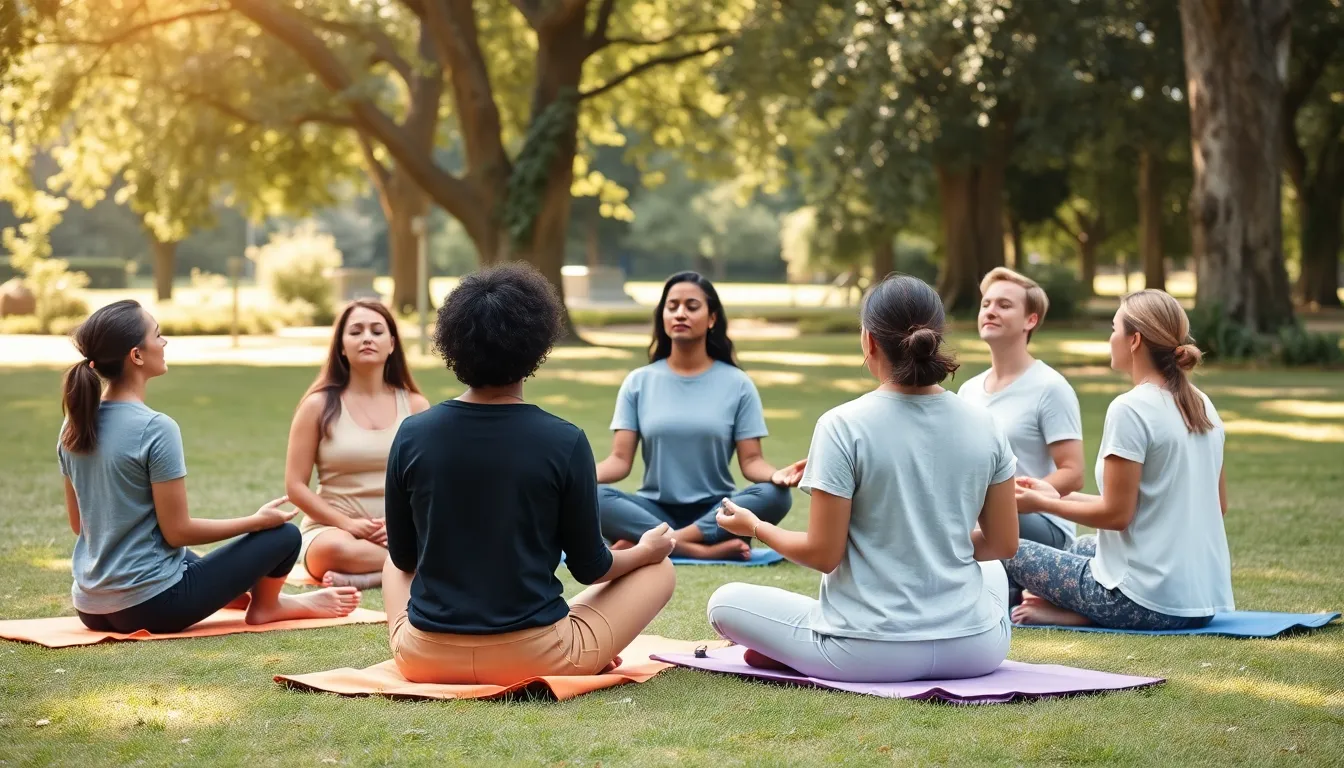In today’s fast-paced world, finding a moment of peace can feel like searching for a needle in a haystack. But what if there was a way to transform that chaos into calm, all while bonding with others? Mindfulness exercises for groups offer just that—a chance to hit pause, breathe deeply, and connect with those around you.
Imagine a room full of people, not staring at screens but sharing smiles and laughter as they engage in simple yet effective mindfulness practices. It’s like a group hug for the mind! These exercises not only reduce stress but also foster teamwork and creativity, turning colleagues into comrades. So why not trade the hustle for harmony? Let’s explore how these engaging exercises can elevate group dynamics and create a more mindful environment.
mindfulness exercises for groups
Mindfulness exercises for groups promote unity and mental clarity. These practices help participants connect with themselves and each other.
Importance of Mindfulness in Group Settings
Mindfulness fosters awareness among group members. This awareness enhances interpersonal relationships and cultivates empathy. Participants learn to listen actively, which improves communication. Cultivating a mindful environment reduces distractions and creates a safe space for expression. When individuals engage in mindfulness, they develop resilience against stressors that may arise during interactions.
Benefits of Group Mindfulness Practices
Group mindfulness practices lead to numerous advantages. Stress reduction occurs as participants focus on the present moment. Enhanced creativity emerges from open-minded discussions, allowing diverse ideas to flourish. Improved teamwork develops through shared experiences during mindfulness exercises. Participants often report increased motivation and positivity, contributing to a more harmonious atmosphere. Overall, these practices nurture a supportive community culture, essential for collaborative efforts.
Types of Mindfulness Exercises

Mindfulness exercises come in various forms, each fostering connection and awareness within a group. Implementing diverse activities enhances the experience for all participants.
Guided Meditation
Guided meditation serves as a structured approach to mindfulness. In this exercise, a facilitator leads the group through visualizations and imagery, promoting relaxation and focus. Participants often find a shared calm as they listen to calming instructions and music. Sessions typically last between 20 and 30 minutes, allowing ample time for participants to immerse themselves in the experience. This practice emphasizes listening, which cultivates an atmosphere of trust and openness among group members.
Breathing Techniques
Breathing techniques focus on integrating breath awareness into mindfulness routines. Different methods, such as deep belly breathing or rhythmic inhalations and exhalations, help participants anchor their thoughts and reduce anxiety. Implementing these exercises requires a commitment of just a few minutes, making them accessible at any point during group engagements. Incorporating breathing practices into regular meetings fosters a shared sense of calm, enabling participants to reconnect and approach discussions with clarity and focus.
Group Discussions and Sharing
Group discussions and sharing encourage participants to express thoughts and feelings after mindfulness exercises. Engaging in open dialogue allows individuals to process experiences and insights gained from their practice. Setting ground rules for respect and confidentiality can create a safe environment for sharing. This collective reflection nurtures connections, enhances understanding, and builds a sense of community. Participants often relate to one another’s experiences, deepening empathy and camaraderie within the group.
Implementing Mindfulness Exercises in Groups
Creating a supportive environment for mindfulness exercises enhances their effectiveness. Participants thrive in spaces that promote relaxation and focus.
Setting Up the Environment
Selecting a quiet and comfortable space is crucial for group mindfulness exercises. Soft lighting and comfortable seating foster a calming atmosphere. Natural elements, like plants or soothing sounds, contribute to relaxation. Minimizing distractions through phone silencing or using noise-canceling headphones helps participants engage fully. Encourage an inviting room layout that promotes togetherness, allowing for eye contact and connection among participants.
Duration and Frequency of Sessions
Establishing the right duration and frequency maintains participant engagement in mindfulness practices. Sessions lasting 20 to 30 minutes often provide ample time for exercises without overwhelming participants. A weekly schedule, with sessions consistently held on the same day, reinforces routine and commitment. Consider varying session times to accommodate different schedules. Regularly updating themes or practices keeps the group experience dynamic and engaging.
Measuring the Impact of Mindfulness Exercises
Measuring the impact of mindfulness exercises helps gauge their effectiveness in a group setting. Participant insights and observable changes in dynamics provide valuable data for assessing progress.
Participant Feedback
Feedback from participants often highlights increased clarity and reduced stress. Surveying individuals after sessions reveals enhanced feelings of connection and support. Many report improved communication skills as they practice active listening. Participants frequently mention the positive shift in their emotional well-being, indicating greater overall satisfaction in group engagements. Collecting this feedback allows facilitators to adapt future exercises based on the group’s needs and interests.
Observable Changes in Group Dynamics
Observable changes in group dynamics occur as mindfulness practices are integrated. Participants typically experience stronger camaraderie, fostering deeper relationships among group members. Greater empathy emerges, enhancing mutual understanding and reducing conflict. Increased collaboration becomes evident as individuals engage more openly in discussions. Facilitators often note improved teamwork, where participants contribute ideas with confidence and respect. These transformative shifts can lead to a more cohesive and resilient group environment.
Conclusion
Mindfulness exercises for groups offer a transformative approach to enhancing interpersonal connections and creating a supportive atmosphere. By integrating these practices into regular meetings or gatherings, groups can cultivate a sense of unity and shared purpose. Participants often find themselves more engaged and motivated, leading to improved teamwork and collaboration.
The positive effects of mindfulness extend beyond individual benefits. As group members practice active listening and empathy, they foster a culture of understanding that can significantly enhance group dynamics. With a commitment to mindfulness, groups can navigate challenges more effectively and thrive in a fast-paced world. Embracing these exercises can pave the way for lasting change and a more harmonious environment.

